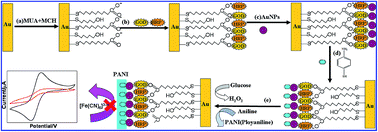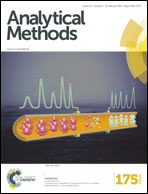A glucose biosensor based on the polymerization of aniline induced by a bio-interphase of glucose oxidase and horseradish peroxidase†
Abstract
A novel glucose biosensor was developed based on a 4-amino thiophenol/Au nanoparticle/glucose oxidase (GOD)–horseradish peroxidase (HRP)/6-mercapto-1-hexanol-11-mercaptoundecanoic acid/Au electrode. The modified electrode could be used to detect glucose based on the polymerization of aniline induced by HRP and H2O2 which was produced by the reduction of O2 accompanied by the oxidation of glucose into gluconic acid via GOD. With the increase of glucose, more H2O2 molecules were produced and then a growing number of polyaniline (PANI) molecules were formed on the modified electrode surface, which resulted in the decrease of peak current of Fe(CN)63−/4− because the formed PANI hindered the electron transfer of Fe(CN)63−/4− toward the electrode surface. Based on the decrease of peak current of Fe(CN)63−/4−, the glucose concentration could be determined accurately and selectively. The resulted biosensor exhibited a wide linear range from 16.5 μM to 10.0 mM, a high sensitivity of 41.78 μA mM−1 cm−2 and good selectivity. The glucose biosensor exhibits some advantages over the traditional GOD electrodes in terms of a close to zero applied potential. Moreover, the used electrode might be used as a H2O2 sensor due to its good electrocatalytic response for H2O2.


 Please wait while we load your content...
Please wait while we load your content...